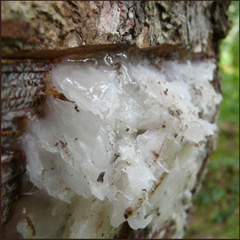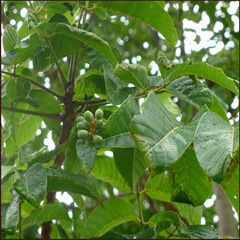 |
|
circulating-oils-library.com |
 |
| circulating-oils-library.com |
Translate this page:
Summary
Endemic to the Philippines, Manila Elemi or Canarium luzonicum is a large, evergreen tree that reaches up to 30 m high upon maturity. It is a great source of a fragrant oleoresin called elemi which has a wide range of uses in food, medicine, and industrial applications. A single tree produces 4 ? 5 kilograms of this resin. The seeds can be consumed raw or cooked. The nuts are sweet and have a delicious flavour. Oil from seed is used in cooking. The fruit pulp is cooked while young shoots can be eaten raw. The oleoresin from the tree, as well as the oil obtained from it, has medicinal value. It is antibacterial, antifungal, antiseptic, antispasmodic, and rubefacient. It is also used against fevers and chills, arthritis, burns, etc. The bark is used for postpartum baths. The wood of Manila elemi is used in light constructions as it is not very hard.
Physical Characteristics

 Canarium luzonicum is an evergreen Tree growing to 30 m (98ft) by 20 m (65ft).
Canarium luzonicum is an evergreen Tree growing to 30 m (98ft) by 20 m (65ft).
See above for USDA hardiness. It is hardy to UK zone 10. The flowers are pollinated by Insects. The plant is not self-fertile.
Suitable for: light (sandy), medium (loamy) and heavy (clay) soils and prefers well-drained soil. Suitable pH: mildly acid, neutral and basic (mildly alkaline) soils. It cannot grow in the shade. It prefers moist soil.
UK Hardiness Map
US Hardiness Map
Synonyms
Canarium carapifolium G.Perkins Canarium oliganthum Merr. Canarium polyanthum G.Perkins Canarium tri
Plant Habitats
Edible Uses
Edible Parts: Fruit Oil Seed Shoots
Edible Uses: Oil
Seed - raw or cooked. The sweet nuts have a delicious flavour when roasted and are served like almonds[ 301 ]. They can also be used in confections, ice cream, nut milks etc, and as an adulterant to chocolate[ 301 ]. The coat surrounding the kernel should be removed since it can cause diarrhoea[ 63 ]. The shell is very thick and difficult to crack, though some thinner shelled forms have been found[ 63 ]. A sweet oil obtained from the seed is used for cooking purposes[ 301 ]. The fruit pulp is boiled and eaten[ 301 ]. Rather tasteless[ 63 ]. An oil can be extracted from the fruit pulp[ 301 ]. It has a tangy, resin-like flavour[ 301 ]. Young shoots - raw[ 301 ]. Eaten in salads[ 301 ].
References More on Edible Uses
Medicinal Uses
Plants For A Future can not take any responsibility for any adverse effects from the use of plants. Always seek advice from a professional before using a plant medicinally.
Antibacterial Antifungal Antirheumatic Antirheumatic Antiseptic Antispasmodic Antitussive Febrifuge
Parasiticide Poultice Rubefacient Skin
Manila elemi (the oleoresin obtained from the tree), and the essential oil distilled from the resin, have a long history of medicinal use. They are considered to be antibacterial, antifungal, antirheumatic, antiseptic, antispasmodic and rubefacient[ 360 ]. A study on the composition of Manila elemi oil from the distillation of elemi resin yielded 39 compounds, with limonene, the most abundant at 56%[ 360 ]. A corn-sized drop of the resin is taken with water in the treatment of fevers and chills[ 360 ]. The oleoresin is applied externally to arthritic and rheumatic joints, boils, abscesses, furuncles, burns and sores[ 360 ]. It is heated and applied to the chest as a poultice to stop severe coughing[ 360 ]. The tree bark is commonly used for postpartum baths[ 360 ]. The essential oil is an ingredient of a commercial preparation called 'Lysout', a natural anti-lice foaming gel that also contains Echinacea purpurea[ 360 ].
References More on Medicinal Uses
The Bookshop: Edible Plant Books
Our Latest books on Perennial Plants For Food Forests and Permaculture Gardens in paperback or digital formats.

Edible Tropical Plants
Food Forest Plants for Hotter Conditions: 250+ Plants For Tropical Food Forests & Permaculture Gardens.
More

Edible Temperate Plants
Plants for Your Food Forest: 500 Plants for Temperate Food Forests & Permaculture Gardens.
More

More Books
PFAF have eight books available in paperback and digital formats. Browse the shop for more information.
Shop Now
Other Uses
Essential Furniture Ink Oil Parasiticide Resin Tannin Varnish Waterproofing Wood
Other uses rating: High (4/5). Other Uses: An oily resin called Manilla elemi is obtained from incisions in the bark[ 46 , 317 ]. Manila elemi is a soft and fragrant oleoresin, oily, pale yellow to greenish, of honey consistency, balsamic in odour and bitter tasting[ 360 ]. It is used in varnishes and inks; for caulking boats; torches; perfumery and for various medicinal applications[ 46 , 317 ]. It can be used for the same purposes as turpentine[ 46 ]. A tannin of reasonable quality is obtained from the bark[ 402 ]. The wood is not very hard. It is used for light construction[ 402 , 451 ]. This species is one of the sources of kedondong timber, which is obtained from several species in the family Burseraceae[ 884 ]. However, the tree is more highly valued for its resin and edible seed and so is little harvested for its wood. We do not have a specific description of the wood for this species, but the general description of kedondong wood is as follows:- The heartwood is generally a light brown; it is not sharply demarcated from the 3 - 5cm wide band of lighter-coloured sapwood. The texture is moderately fine and even; the grain is interlocked to wavy; the surface is lustrous. The wood is light in weight; moderately hard; not very durable, being susceptible to fungi, dry wood borers and termites. It seasons somewhat slowly with only a slight risk of checking and distortion; once dry it is moderately stable to stable in service. The wood has a fairly high blunting effect, stellite-tipped and tungsten carbide tools are recommended; it is moderately easy to slightly difficult to plane; finishes smooth to rough; can be easy to very difficult to bore; slightly difficult to difficult to turn; nailing and screwing properties are good; gluing is correct. The wood is suitable for internal use as a general utility timber for planking, cladding, plywood, flooring, furniture, packing cases, pallets and general carpentry work[ 316 , 848 ].
Special Uses
Carbon Farming Food Forest
References More on Other Uses
Cultivation details
Management: Standard Regional Crop Staple Crop: Oil
A single tree yields 4 - 5 kilos of resin[ 402 ]. Wild forms usually have three, sometimes two kernels present in the nut, each in its own compartment[ 63 ]. In the case of cultivated trees, however, only one kernel is sometimes found in each nut[ 63 ]. When this is so, the kernel is proportionately larger and the nut easier to crack[ 63 ]. Trees are dioecious, both male and female forms need to be grown if fruit and seeds are required.
Carbon Farming
-
Management: Standard
Plants grow to their standard height. Harvest fruit, seeds, or other products. Non-Destructive management systems.
-
Regional Crop
These crops have been domesticated and cultivated regionally but have not been adopted elsewhere and are typically not traded globally, Examples in this broad category include perennial cottons and many nuts and staple fruits.
-
Staple Crop: Oil
(0-15 percent protein, 16+ percent oil). Some of these are consumed whole while others are exclusively pressed for oil. Annuals include canola, poppyseed, maize, cottonseed, sunflower, peanut. Perennials include high-oil fruits, seeds, and nuts, such as olive, coconut, avocado, oil palm, shea, pecan, and macadamia. Some perennial oil crops are consumed whole as fruits and nuts, while others are exclusively pressed for oil (and some are used fresh and for oil).
References Carbon Farming Information and Carbon Sequestration Information
Temperature Converter
Type a value in the Celsius field to convert the value to Fahrenheit:
Fahrenheit:
The PFAF Bookshop
Plants For A Future have a number of books available in paperback and digital form. Book titles include Edible Plants, Edible Perennials, Edible Trees,Edible Shrubs, Woodland Gardening, and Temperate Food Forest Plants. Our new book is Food Forest Plants For Hotter Conditions (Tropical and Sub-Tropical).
Shop Now
Plant Propagation
Seed - we have no specific information for this species but seeds of this genus generally have a hard seed coat and germinate erratically. Filing away some of the seed coat to allow moisture to enter more readily, without damaging the seed, will encourage a faster and more even germination[ 658 ].
Other Names
If available other names are mentioned here
Manila Elemi or Canarium luzonicum. Other Names: Elemi, Pining-liitan.
Native Range
TROPICAL ASIA: Philippines,
Weed Potential
Right plant wrong place. We are currently updating this section.
Please note that a plant may be invasive in one area but may not in your area so it's worth checking.
None Known
Conservation Status
IUCN Red List of Threatened Plants Status : Status: Vulnerable A1cd

Growth: S = slow M = medium F = fast. Soil: L = light (sandy) M = medium H = heavy (clay). pH: A = acid N = neutral B = basic (alkaline). Shade: F = full shade S = semi-shade N = no shade. Moisture: D = dry M = Moist We = wet Wa = water.
Now available:
Food Forest Plants for Mediterranean Conditions
350+ Perennial Plants For Mediterranean and Drier Food Forests and Permaculture Gardens.
[Paperback and eBook]
This is the third in Plants For A Future's series of plant guides for food forests tailored to
specific climate zones. Following volumes on temperate and tropical ecosystems, this book focuses
on species suited to Mediterranean conditions—regions with hot, dry summers and cool, wet winters,
often facing the added challenge of climate change.
Read More
Expert comment
Author
(Blume) A.Gray
Botanical References
Links / References
For a list of references used on this page please go here
A special thanks to Ken Fern for some of the information used on this page.
Readers comment
| Add a comment |
|
If you have important information about this plant that may help other users please add a comment or link below. Only comments or links that are felt to be directly relevant to a plant will be included. If you think a comment/link or information contained on this page is inaccurate or misleading we would welcome your feedback at [email protected]. If you have questions about a plant please use the Forum on this website as we do not have the resources to answer questions ourselves.
* Please note: the comments by website users are not necessarily those held by PFAF and may give misleading or inaccurate information.
To leave a comment please Register or login here All comments need to be approved so will not appear immediately.
|
Subject : Canarium luzonicum
|
|
|
|